GLIMPSES INTO SOME STOUR VALLEY CHURCHES
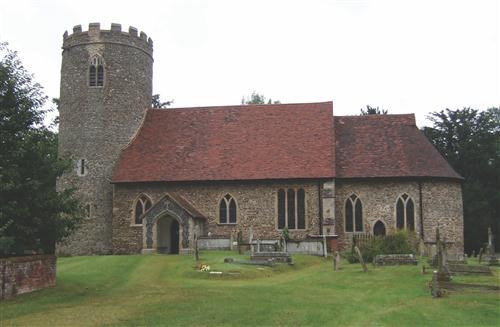
St. Gregory & St. George Church at Pentlow.
As the Team Vicar of the North Hinckford Team Ministry I have the cure of souls in the parishes of Great & Little Henny, Twinstead, Alphamstone, Lamarsh, Middleton and Wickham St Paul’s. I use this description, which seems rather quaint and perhaps old-fashioned, since the Latin “curare” meant care, responsibility. For twenty five years prior to coming to these parishes I was a curator of museums and the verb “curate” also derives from that same Latin word “to care for and have responsibility for the well-being of”. This is rather neat as I love people and I love old buildings. As a museum curator I was also looking after listed buildings and trying to get people over the threshold to inspire them, and now as a vicar I am still trying to get people to come in over the threshold to be inspired!
When your Editor suggested that I might write an article on some of the churches along the Stour, I grasped the opportunity to explore, and it has also re-awakened in me the desire to write articles again. Obviously I could write lots about the six churches in my immediate care, or even many of the 15 churches in this Team Ministry. Instead I chose to start at the northern tip of the Stour in the area shown on your map, and finish at the southern end of the map. There are far too many churches to cover in one article so this is something of a pot-pourri. I have picked out a few to give you a feel for a visit to these wonderful buildings. I am not going deeply into their history, but each has a distinctive flavour, and I hope that if this article inspires my readers to visit these churches, then I shall be well pleased. All the churches mentioned are open with the exception of two, and I shall describe how to obtain the key for those. I should also mention that I decided to miss out Sudbury altogether, as the churches there merit an article by itself.
I began my quest at Kedington, St Peter & St. Paul’s. I read nothing up beforehand and the exterior seemed quite large, but nothing prepared me for what I beheld when I opened the heavy door: inside, my first impression was that of a huge lumber-room! I wondered whether the church was in the midst of alterations and indeed it was, but this did not really account for the fact that there seemed to be something from every ecclesiastical age and fashion somewhere within this somewhat cluttered interior. The nave seemed very dark and full of wood: a jumble of box pews, a 17th century triple decker pulpit, tiered seating for Sunday school pupils climbing up the rear walls, a gorgeous musicians’ gallery in the west end, a crazy floor which lurched its way down the aisle to a much lighter, brighter area: the choir and sanctuary. Because this is so light in contrast to the darker nave, you are drawn into the lighter, less congested space where a beautiful early 20th century reredos shows the Blessed Virgin and the infant Christ. Above this is a Saxon stone crucifix rescued from the churchyard, the oldest thing in the church and crucially showing the heart of our faith.
On my way down to the altar I passed a very imposing Squires box pew facing the recumbent figures of the Barnadistones in their beautiful clothes, solidly at peace in God’s eternity. Now the Barnadistones have an immediate link with Great & Little Henny, as the “big house” in Henny, The Ryes, was owned by this family and they were generous to Henny church. Some of this family are buried in that churchyard. I bought the guide book and discovered that the jumble I was sitting amongst has also been described as the Westminster Abbey of Suffolk. I understood why I felt as I did: I’m not too keen on Westminster Abbey either! I think I would find the clutter difficult to cope with while worshipping: a distraction but perhaps it’s only my unfamiliarity, and that it would soon grow on me. This made me wonder: although I love museums, which are storehouses of ancient treasures, I am not sure I want my churches to be exhibition pieces of church architecture and toot from every age!
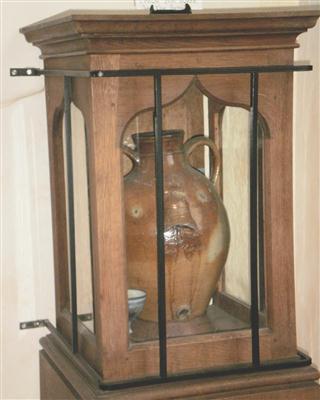
Bell Ringers Gotch at St. Peter and St. Paul’s Church, Clare.
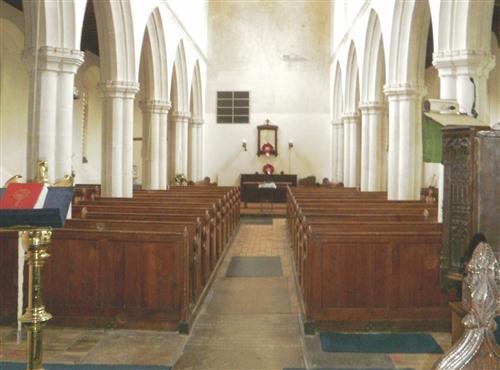
Calm Interior of Stoke by Clare Church.
Outside in the fresh air I took to the road and tried, but failed, to visit Wixoe (the road being closed) so I next found myself at another church which was in complete contrast to Kedington: St John the Baptist, Stoke by Clare. On entering, the calm interior soothed me immediately, as did the wonderful aroma of furniture polish, and sure enough there was a very friendly welcome from the lady whose turn it was to tend her church in this very tangible way. This church is beautifully ordered, serene even. It is tidy and light and seems almost all of a piece. I don’t know whether it was the juxtaposition of these two visits: would I have felt differently had I visited on separate occasions? This is certainly an oasis of peace where it would be easy to become lost in prayer.
Before the Reformation there was a College of Secular Priests settled here and a certain Matthew Parker was its last Dean. This cleric, a wise and moderate man, was Chaplain to Henry VIII and had the charge of the young Elizabeth I on the death of Anne Boleyn. When Elizabeth became Queen she made Parker Archbishop of Canterbury. However there was one problem: Matthew Parker was a married priest and Elizabeth disapproved of married clergy. She visited Lambeth Palace and enjoyed Margaret Parker’s hospitality but said to Margaret: “Madam, I cannot call you Mistress, I would be ashamed to call you (that) but whoever you are I thank you”. Matthew was involved with the detailed management of Lambeth Palace and earned himself a nickname still in currency today; he was the original “Nosey Parker”.
In this lovely church there is a side chapel, the Elwes Chapel: this is the Squire of Stoke’s chapel. Two members of this family were real misers wearing hand- me down clothes and mending broken windows with brown paper. One of them looked so impoverished that people would offer him alms, yet this same man was a successful businessman leaving £300,000, a colossal sum in those days. He was M.P. for Berkshire and his last words are reported to be “I will keep my money – I will”! On to Clare’s lovely church of St Peter and St Paul, which stands squat and squarely in the very middle of this delightful little town. This church always has people coming and going within it. There is a delightful children’s corner and this congregation goes out of its way to welcome children. I often pop in to browse the bookstall. Also on sale is a good range of greetings cards and other little gifts. The church possesses a sturdy 18th century bell-ringer’s “gotch” (beer jug) and it has a ring of 8 bells. Clare church, like many others in our area suffered much from the iconoclasm of the Commonwealth men. William Dowsing wrote in his journal of his visit to Clare in 1643: We brake down 1000 Pictures superstitious; I brake down 200; 3 of God the Father, and 3 of Christ, and the Holy Lamb, and 3 of the Holy Ghost like a Dove with Wings; and the 12 Apostles were carved in Wood, on the top of the Roof, which we gave order to take down; and 20 Cherubims to be taken down; and the Sun and Moon in the East Window, by the King’s Arms, to be taken down. However, Dowsing’s followers were not always as zealous as himself: the cherubim were not destroyed and the sun and moon are still in the east window of the chancel. The other special place in Clare is at the Priory: the Shrine of our Lady, Mother of Good Counsel, where there is a relief of The Virgin Mary by Mother Concordia OSB based on a fresco at Genazzano near Rome. The tiny heavily timbered shrine is the oldest part of the Priory (13th century). The metal relief sculpture sparkles in the dark interior, as the reflected light of candles dance on its surface. Behind the sculpture, the cream wall is framed by dark heavy curtains, and above is a semicircular cap painted in virginal blue. This lovely intimate space is steeped in prayer and is a place of great solace.
Clare Priory was the first Augustinian foundation in England. It was established in 1428 but after the dissolution of monasteries, in 1538, the house passed through many hands and uses until the Augustinian Friars purchased the house in 1953, and returned to their English roots.
Just a few miles along the road (A1092) and we arrive in Cavendish, a village much-favoured by calendar photographers. I have seen quite a change in this church of St Mary over the last few years. When I first visited, it seemed rather grey, and a bit dead, to be honest. On this last visit the church seems to have come alive and in little subtle ways I felt that the congregation seems to have blossomed. This building exudes restraint and refined culture. There is a large tomb of the Protestant Sir George Colt, which is quietly overlooked by a modern statue of Mary with the baby Jesus, which must have replaced a former pre-Reformation one in a beautiful canopied niche whose rear wall is a striking Marian blue. In complete contrast to the rest of this church there is an amazingly flamboyant treasure: a wildly coloured Flemish reredos from 16th century showing a crucifixion scene all complimented by a frame made by Ninian Comper whose colourful work is seen in many Anglo- Catholic churches.
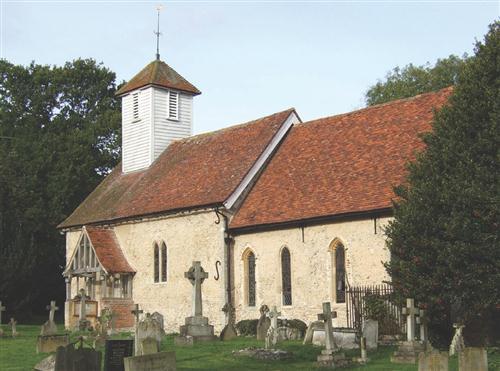
Middleton Church.
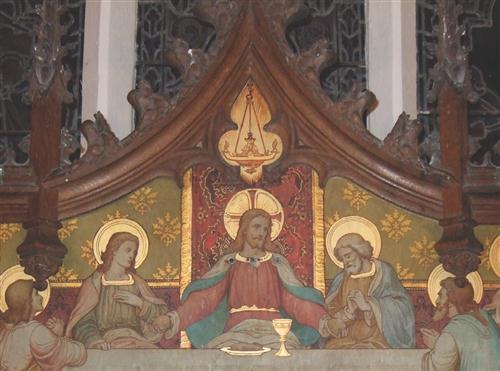
Reredos in Middleton Church.
From Cavendish we cross the river to Pentlow (St Gregory and St George) which is sadly locked. . .but it is well worth obtaining a key from the churchwarden (Mrs June Turner 01787 280438) to visit this secret gem. It lies tucked away up a little path and is closer to Cavendish than the main part of Pentlow. Not long after I arrived in this area, this church’s round tower (one of only 6 in Essex) was struck by a ball of lightning causing a fair amount of damage, but the church is now beautifully restored. Entering, you cannot help but be amazed at the square font, which is 12th century, with elaborate carvings and its unusual carved wooden font cover with three panels which are opened for christenings. The North Chapel (1600) is the resting place of Judge Kemp and his son, John, and daughter-in- law, Elinor, and clustered round these silent recumbent figures are their 10 daughters and 4 sons, all united in death. We can reflect and give thanks that scientific and medical advances mean that infant mortality, on this kind of scale, is almost unheard of in our western world. This church has a lovely warm atmosphere with its rich warm wooden roof, which reminds me of an upturned boat set beautifully against the plain white walls. This church is clearly loved and well cared for.
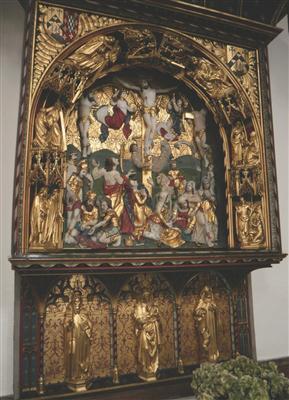
Flamboyant Reredos in Cavendish Church.
Ignoring Sudbury, let us continue along the southbank of the Stour taking the road, at the Ballingdon traffic lights, towards Lamarsh and Bures. About a mile and a half along this road turn right into Middleton. This tiny village is tucked away, perfectly formed round a circular lane and footpath close to Sudbury. The approach to All Saints church seems as if one is entering private grounds: it shares the access road with Queens Beeches which was the former rectory. The gravel path beside the church provides an excellent site for the annual Boules Tournament which raises funds for the church. The church doorway has a mass (or scratch) dial on its right lintel, while the wonderful ancient door has a Norman surround with the typical zigzag patterning. On entering, do be careful of a steep step down into the gloom, so allow your eyes to grow accustomed to the darkness. Facing the door is an enormous darkened painting, thought to be by Schiavone (16th century), of the Annunciation. This church is well-cared for and has recently formed a very active Friends organisation. Unusually the Choir is the same size as the Nave. Here in the 1920s the peace of this village church was shattered by the paparazzi of the day and by strident folk who came out to protest from Sudbury. What stirred up the good souls of Sudbury was the claim by the then Rector, Revd Clive Luget and a Doctor, and his son, who claimed to have seen a vision, on more than one occasion, of The Blessed Virgin Mary standing on a little mound in the Rectory garden. This brought out the usual Protestant versus Catholic sentiments. Fr Luget was High Church and made no concessions to his middle of the road congregation; consequently only a few attended church. However there are people still in this village today, who remember Fr Luget’s kindness especially to the children of the village. In spring, it is a sheer delight to see this churchyard covered in drifts of quietly nodding snowdrops and the stained glass is lovely whether on a sunny morning or in the evening when the church is lit for services. Do not miss the fine gilded reredos showing the Last Supper. You do need to come right up to the altar to appreciate its full beauty. This church is open, though the handle sometimes proves difficult to turn.
Coming through Henny Street if you look west, on top of the hill you will see a church with a tilted spire 233.2 feet above sea-level (and with a bench mark to prove it!). This is St Mary’s Great Henny, built between 1066 and 1599, and its tower built 1066 – 1199.
It is the church I know best. I say my Morning Prayers there since the Rectory is just down a track south of the church. It is always windy at St Mary’s, which sits atop a plateau overlooking the Stour Valley. St Edmund’s Way and the Stour Valley footpath pass through the peaceful churchyard, so the church is often visited by walkers, who rest and shelter from the elements, glad of its welcoming open door. Inside, there is a surprisingly large Sanctuary area which makes this church a wonderful venue for a varied concert programme. On the east wall are beautiful stained glass windows, probably by Hardman, vibrant with strong blues and reds. An unusual aspect of this church are the painted medieval corbel carvings at the end of roof timbers: playing medieval musical instruments: bagpipes, the shawm, and a harp, among other things. Here are two grotesque red devils’ heads with white teeth, grinning or grimacing at the congregation! Woodpeckers adore this church: drumming on the wooden shingles of the spire makes the most wonderful sound to a female woodpecker. Unfortunately, it causes the spire to resemble a sieve, after prolonged years of drumming, so in 2000 this tiny community managed to raise funds to replace the spire, and they chose much harder oak shingles to replace the old cedar ones. This church is also the subject of the centre of one of Gainsborough’s paintings which hangs in the National Gallery. Titled Cornard Wood, it depicts a heavily wooded scene with a church in the middle distance. This is thought to be St Mary the Virgin, Great Henny. If you visit the Henny Swan, in its Gainsborough Restaurant there is an enlargement of this painting which shows greater detail of the church, which had a different spire in those days. Today, both Great Henny and St Andrew’s Great Cornard, across the river, have typical Essex shingled broach spires.
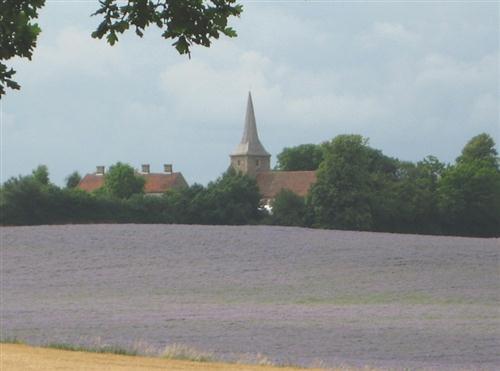
Great Henny Church and Borage Field.
The hymn “My Song is Love Unknown” by Samuel Crossman (1624? – 1684) may have been written at Little Henny (though the people at All Saints, Ballingdon in Sudbury also think this!); perhaps because he was Rector of both All Saints, and Little Henny Church (which burned down in 17th century and was never rebuilt). The scant remains of Little Henny Church lie in the grounds of the Ryes.
Thence, on to Lamarsh, keeping close by the river. Holy Innocents Church, dating from 1174, holds very special memories for me, because it is the church in which I was licensed in May 2005 as Team Vicar in the North Hinckford Team of 15 churches. This is our second Round Tower Church, and it is well looked after by a very active Friends Group. The dedication to the Holy Innocents is one of only five such dedications in England. In 1797, the round tower was struck by lightning and part of the north side collapsed. It was restored in 1865 and only then was the tower capped by its timber and red tiled spire. The lovely porch is Elizabethan, with a tiny room, accessed by a trap door for visiting priests to sleep in, and inside all is light and very simple; basically one big room which is enhanced by a very delicately carved rood screen (15th century) which was installed when Margaret Beaufort (mother of Henry II) was Lady of the Manor, and may have been gifted by her. On the southern exterior wall there is a carved female head which is thought to be of this lady. A tiny chamber organ, built by George Pike, (1750 -1856) is quite special. The interior is a gorgeous creamy tint as is the exterior, only recently lime-washed. We know that hidden under the paint there are medieval wall paintings. At the east end there is a beautiful large triple window: the work of arts and crafts stained glass artist Mary Lowndes (1857 – 1929) installed in 1895.
Here are dragons. . . St. Andrews, Wormingford sits on a high bank above the Stour surrounded by a beautifully kept old churchyard. Below lies Smallbridge Hall where Sir William Waldegarve entertained Queen Elizabeth I. Looking across the Stour Valley you look back to where Edmund was crowned on that Christmas Day so long ago. Inside, the church is furnished with dark wood everywhere. It is comforting to reflect that this wood shines by dint of the work of hundreds of duster- wielding hands polishing all to attain such a fine patina. There is a lovely painting which depicts a crucifix at a harbour, with a few people gathered round a priest, perhaps blessing fishing boats; it looks French to me, and this has a wooden plaque below which was a bit obscured by a fine Christmas tree, when I visited in December. The inscription is about returning to a safe haven and is given in thanks for the safe return of people from the 1914 – 18 War.
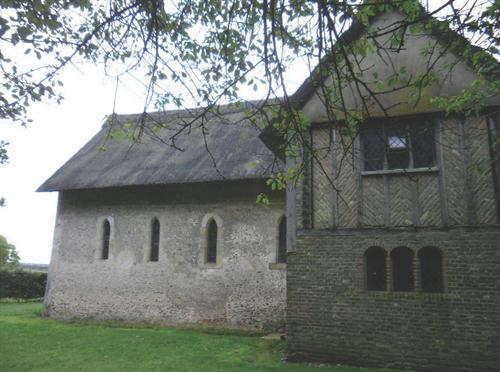
St. Stephen’s Chapel Barn, Bures
A few miles more and we enter Bures Hamlet, on the Essex side of the River Stour, and cross over the bridge, into Suffolk, into Bures St Mary’s, named after the church which sits securely in the centre of the village. This church has a busy programme of weekly groups and events. Inside, it seems to be only concerned with the present and the future as I could find no information at all within the church, which tells of its history or past events. No architectural details. This is not a criticism, it just tells you where the congregation’s hearts are focussed. If you have access to a computer and go on-line to Bures-online.co.uk, from this page you are invited to take a panoramic tour from the church tower, which is well worth doing, especially if, like myself, you suffer from vertigo, and tend not to climb church towers. I then made a slight detour up Cuckoo Hill to a rather hidden gem. It is accessed through a farmyard at Fysch House Farm, where keys are available. About half a mile onwards down this farm track you find the little thatched St Stephen’s Chapel (1218) predating St Mary’s in Bures by 150 years. On Christmas Day 855, Bishop Humbert of Elmham anointed a 14-year-old boy as King of the East Angles. This was Edmund who succeeded King Offa. It is generally thought that the coronation took place on this remote hill, set in placid rolling scenery, where St Stephen’s Chapel now stands. Inside the chapel all is dark, until your eyes grow accustomed, and then you suddenly become aware of the effigies of three Earls of Oxford, the only survivors of twenty-one tombs, once found at Earls Colne Priory. At least, there appear to be three: close inspection by expert eyes has suggested that they are in fact made up from pieces of seven separate monuments. The disused Chapel of St Stephen’s was converted to a hospital during the plague of 1739 and then became cottages and eventually a barn, hence its local name “Chapel Barn”. It was restored in the 1930s, by members of the Probert family, and re-consecrated. This place has a very special atmosphere, and you feel history becomes almost tangible here.
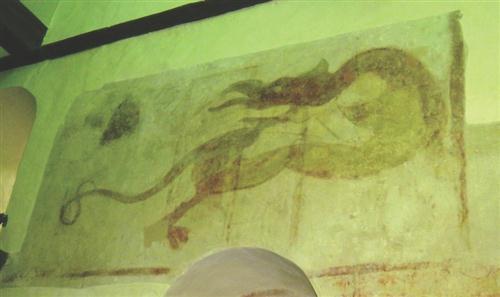
St. Mary’s Dragon, inside Wiston church.
I finished my journey at a church to which I keep returning, because it is a lovely little treasure and there is a great sense of a church beloved by its community. You park the car and walk along a lovely track, which leads to a little Georgian house, Wissington Hall, estate farm, and the church of St Mary itself. The present appearance of the church is largely the due to Charles Birch, Rector from 1832. He removed the 15th century windows replacing them with the present neo-Norman ones; he removed the eastern wall and created an apse,which looks much older than it is, but which stands on the site of a Norman apse. He also added, at the west end, a mock-Romanesque gallery, and the oak benches. Birch also uncovered the medieval wall paintings, but covered them again, considering them to be distracting to the congregation! They were uncovered once more by Professor Tristan in 1932, but the wax treatment he applied, for their preservation, had the opposite effect, trapping in damp.
In the tiny south porch there is a veritable library of pre- owned (as they say now, instead of second-hand) books which I always fall for in churches. Inside, all appears dim at first, but allow time for your eyes to take in the beauty of this little sacred space. Don’t rush; allow yourself to breathe deeply, and then go over to the north wall and turn on the new lighting system, which very gently and slowly illuminates the whole interior, in a quite magical way. This has been extremely well- designed and thought out, really enhancing the experience of this lovely place. Then, you can properly examine the 13th century wall paintings, including the earliest representation in England of St Francis of Assisi, feeding the birds. On the north wall there is a great reddish coloured dragon. Is he related to the monster from which Wormingford takes its name? Or, the green one from Bures? In 1405, the Chronicle of Henry de Blaneford of St Albans Abbey wrote about such a dragon: “In these days there appeared an evil dragon of excessive length with a huge body, crested head, saw-like teeth and elongated tail in land near the town of Bures, which destroyed and killed a herd of sheep. The servants of Sir Richard Waldegarve came forth to shoot it with arrows which sprang back from its ribs as if they were hitting bronze plates.” Also in the 15th century, another chronicle, surviving in Canterbury Cathedral’s library, mentions this incident: “On the afternoon of Friday, 26th September, 1449, two giant reptiles were seen fighting on the banks of the River Stour (near the village of Little Cornard) which marked the English county borders of Suffolk and Essex. One was black, and the other ‘reddish and spotted’. After an hour-long struggle that took place ‘to the admiration of many [of the locals] beholding them’, the black monster yielded and returned to its lair, the scene of the conflict being known ever since as Sharpfight Meadow” (opposite Henny Swan). So the Red spotted Essex dragon won that battle.
And so ends my first exploration of a few of these wonderful churches in our beautiful valley. My own parishioners know the importance I attach to churches being open all week and not only for one hour on a Sunday. An open church is a sign of welcome, and is proof that the church is not just there for those who attend services on Sundays; in some of our villages they are the only public gathering place. These churches are there to be used: for prayer and worship of God; and their stones tell of the centuries of worship offered by these, mostly tiny, communities. Many of the churches are listed, and each one is precious to its community, as our sacred spiritual home where we celebrate births and marriages; say farewell to our loved ones; where we give thanks at Harvest; where we remember in November; and where we follow the ceaseless round of the Christian year.
They are intrinsic elements of our landscape and cultural heritage. They need cherishing with time and money to care for them. Let us never take them for granted.
Reverend Margaret H. King
Margaret King was born in Glasgow, and after attending Bellahouston Academy studied Geology at Glasgow University, followed by research at Liverpool University. She then followed a career in museums, finally as a County Curator of the seven Angus Council Museums. She became a Fellow of the Museums Association. Margaret took Holy Orders in 1998 in Montrose, before joining the Hinckford Team Ministry in 2005. She has transformed those churches where she is “in charge” and congregations have blossomed.
